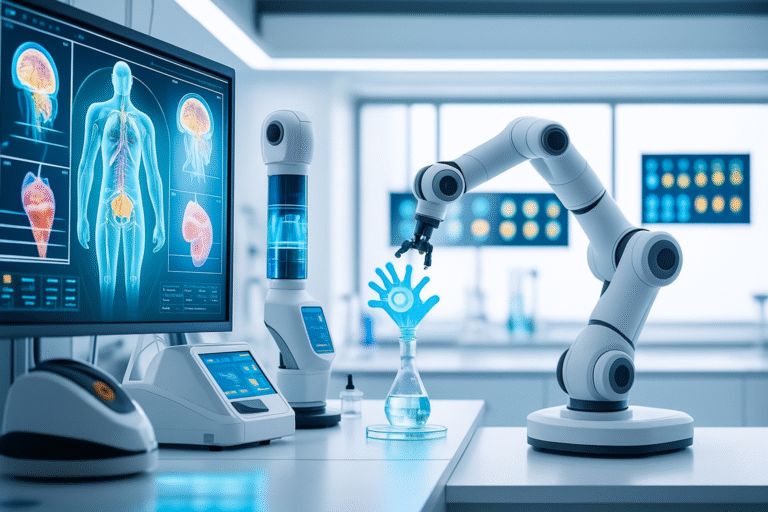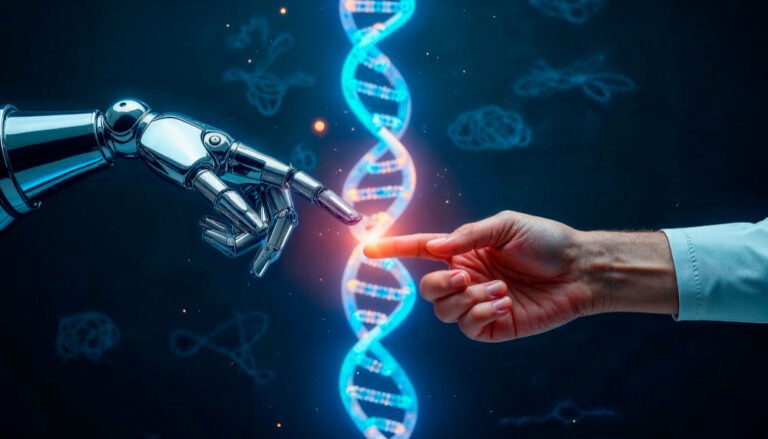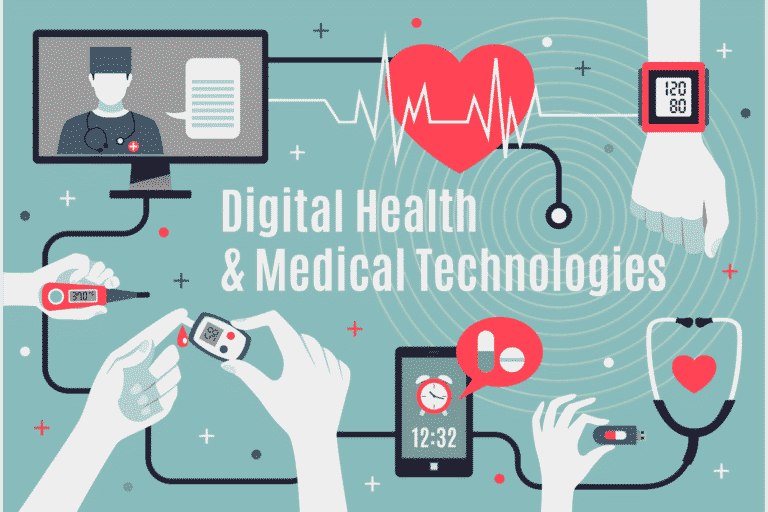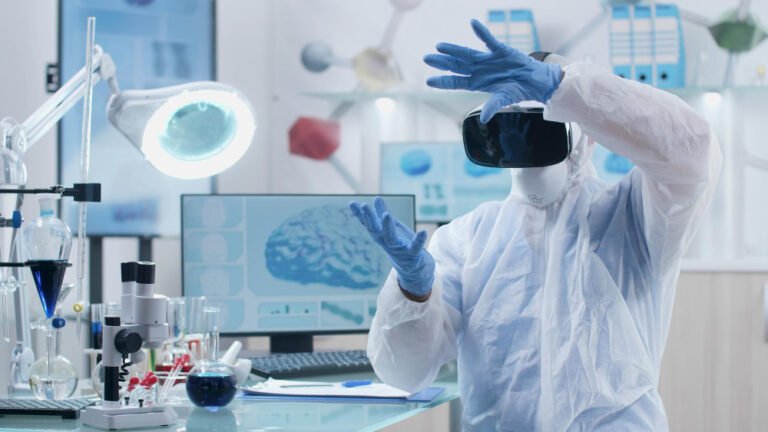New Technologies in the Medical Field: Fantastic Emerging Technologies Explained
The medical field is changing faster than ever, honestly. New technologies are transforming how doctors treat patients and making healthcare more effective.
These cutting-edge tools are improving patient outcomes and changing the way medicine works in 2025.

Ever wonder how all this new tech will affect your own healthcare? From smart computer systems that help doctors make better decisions to tiny robots that can work inside your body, medicine is getting more precise than ever.
Healthcare innovations are boosting patient outcomes through better design and development. These technologies aren’t just some far-off dream—they’re already being used in hospitals and clinics all around the world.
You’ll get a glimpse at some of the most important breakthroughs changing how doctors diagnose diseases, perform surgeries, and help patients heal faster.
What You’ll Learn?
- Smart computer systems and robots are making medical treatments more accurate and effective
- Personalized medicine and wearable devices let doctors create treatment plans just for you
- Remote care and virtual reality are making healthcare easier to access from anywhere
The Impact of Artificial Intelligence in Healthcare
AI is shaking up healthcare in a big way—think diagnostics that spot diseases earlier, predictive models that can forecast outcomes, and automated drug discovery that speeds up new treatments. It’s wild how much data these systems can sift through, finding insights that humans might never notice.
AI-Powered Diagnostics and Disease Detection
Medical imaging systems powered by AI can now identify diseases with jaw-dropping accuracy. AI technologies in healthcare diagnostics use deep learning to analyze X-rays, MRIs, and CT scans, often faster than any human radiologist could manage.
Machine learning models are able to spot early-stage cancers, heart conditions, and neurological disorders. These systems look at thousands of images, picking up patterns invisible to the naked eye.
Key diagnostic applications include:
- Skin cancer detection – AI analyzes photos to identify melanomas
- Diabetic eye screening – Automated systems check for retinal damage
- Pneumonia identification – Chest X-ray analysis in emergency rooms
Your healthcare provider might get instant diagnostic support right during your appointment. AI-powered diagnostic tools are helping to reduce misdiagnosis and speed up decisions.
Basically, the tech compares your scans to millions of others, giving doctors more confidence and catching diseases earlier than ever.
Machine Learning for Predictive Analytics
Your medical data can actually help predict health problems before you even feel sick. Predictive analytics look at your health records, lab results, and vital signs to flag possible issues ahead of time.
Machine learning finds patients at risk for heart attacks, strokes, or readmissions. Healthcare predictive analytics are trained on thousands of cases.
Common predictive applications:
| Application | Purpose | Accuracy Rate |
|---|---|---|
| Sepsis prediction | Early warning systems | 85-90% |
| Fall risk assessment | Prevent patient injuries | 80-85% |
| Medication adherence | Improve treatment outcomes | 75-80% |
Your care team gets alerts when your risk changes, so they can step in before things get serious. That’s pretty reassuring, right?
It’s all about more personalized care, based on your real risk profile, not just averages.
AI in Drug Discovery and Development
Thanks to AI, new medications are coming out faster than ever. The old way of discovering drugs took forever—sometimes more than a decade. Now, it’s way quicker.
Companies like Atomwise and BenevolentAI use machine learning to sift through millions of molecules, predicting which ones might actually help fight disease.
AI speeds up several key processes:
- Target identification – Finding disease-causing proteins
- Compound screening – Testing thousands of potential drugs virtually
- Clinical trial optimization – Selecting the right patients for studies
Your future treatments could be more precise, too. AI in drug discovery is paving the way for personalized medications based on your own genes.
It can even find new uses for old drugs, so you might get a treatment for a rare disease that never had an option before.
Natural Language Processing for Medical Data
Your medical records are actually way more helpful now, thanks to natural language processing (NLP). These AI tools read through doctor’s notes and reports, pulling out the important stuff.
NLP turns all that messy text into data that computers can analyze. That way, doctors get a clearer, faster picture of your health story.
Medical NLP applications include:
- Extracting symptoms from clinical notes
- Identifying drug allergies in patient records
- Coding diagnoses for insurance billing
- Summarizing lengthy medical reports
Your health records get a boost from automated analysis, catching details that could easily be overlooked. It’s a real time-saver and can make a big difference in care.
Data privacy is still a big deal, and these AI systems are designed to keep your info secure. Hospitals and clinics use safe methods to analyze your records without exposing personal stuff.
Honestly, this tech is freeing up doctors from endless paperwork, letting them focus more on you instead of forms.
Personalized and Precision Medicine

Now, doctors can use your genetic makeup to figure out treatments that are way more effective for you. Emerging technologies help doctors provide treatments made just for each patient, leading to better results and, honestly, fewer side effects.
Genomics and Genetic Data Analysis
Your DNA is packed with clues about how you’ll react to diseases and treatments. Genetic data analysis looks for changes in your genes to predict health risks.
It used to take years to read your whole genetic code. Now, it’s done in hours and doesn’t cost a fortune anymore.
Key genetic tests include:
- Whole genome sequencing
- Gene expression analysis
- Genetic variant identification
Doctors can spot disease risks early by looking at your genetic data. They’ll find gene changes that make you more likely to get certain cancers or heart problems.
This info also helps explain why some treatments work for you but not for someone else, letting doctors pick the right meds from the get-go.
Pharmacogenomics and Targeted Treatments
Pharmacogenomics is all about how your genes affect the way medicines work in your body. Your genetic makeup decides how quickly you break down certain drugs.
Some people need higher doses of blood thinners because their bodies process them super fast. Others need less, or they risk serious side effects.
Common pharmacogenomic tests check:
- Drug metabolism genes
- Medication sensitivity markers
- Adverse reaction predictors
Cancer care is getting more personal, too. Doctors can test your tumor for specific gene changes and pick drugs that target those exact problems.
These targeted treatments usually work better and have fewer side effects since they focus on the bad cells, not everything else.
Personalized Treatment Plans Based on Genetic Makeup
Your doctor can now design treatment plans just for your unique genetic profile. This means you’ve got a better shot at getting well, with less risk of side effects.
Personalized treatment considers:
- Your genetic variations
- Family health history
- Lifestyle factors
- Environmental exposures
Prevention is more accurate, too. If your genes show higher risks, your doctor might recommend screening tests earlier than usual.
Multi-omics integration combines different types of genetic data to give doctors a fuller picture of your health. It’s not just your genes—they look at proteins and metabolism patterns, too.
Your treatment plan could include custom drug doses, specific meds, and targeted monitoring. Doctors tweak these plans as they see how you respond.
Advances in Medical Devices and Wearable Technologies

Medical devices are now connected and can keep tabs on your health 24/7. They track everything from your heart rate to blood sugar, all while you go about your day.
Remote Patient Monitoring and Connectivity
Remote patient monitoring (RPM) lets doctors keep an eye on you from anywhere. These wireless devices send your vital signs straight to your healthcare team, no matter where you are.
Your doctor can spot changes before you even notice symptoms. This early warning can help prevent hospital stays and catch problems before they get serious.
Wearable devices are growing in computing power and can now monitor pretty complex health conditions. They track blood pressure, oxygen, and heart rhythm all day long.
Key RPM Benefits:
- Real-time health data collection
- Fewer emergency room visits
- Better medication management
- Earlier detection of health problems
Mobile health apps work with these devices to store your data. Your team can review weeks of info in minutes, instead of relying on one quick office visit.
Smartwatches, Fitness Trackers, and Glucose Monitoring
Smartwatches aren’t just for counting steps anymore. They can detect irregular heartbeats, measure your blood oxygen, and even take ECGs.
Popular Health Tracking Features:
- Heart rate monitoring
- Sleep quality analysis
- Blood oxygen measurement
- Fall detection
- Stress level tracking
Fitness trackers have gotten so good, they’re practically medical devices now. They track your activity and can spot changes that might mean something’s up with your health.
For people with diabetes, glucose monitoring is on another level. Continuous glucose monitors stick to your skin and check your blood sugar every few minutes, no finger pricks needed.
These gadgets connect to your phone and alert you if your blood sugar goes too high or low. It’s way more convenient and less painful than the old method.
The data goes straight to health apps that help you manage diabetes better. Your doctor can finally see patterns in your blood sugar that were impossible to track before.
The Internet of Medical Things in Patient Care
The Internet of Medical Things links up all your health devices into one big network. Your smartwatch, glucose monitor, and blood pressure cuff basically chat with each other behind the scenes.
This kind of connectivity paints a fuller picture of your health than any one device could. If something’s off, one gadget can ping the others and even send a heads-up to your healthcare team.
Connected Device Examples:
- Smart pill dispensers that track when you take your meds
- Connected inhalers to help manage asthma
- Wireless scales that notice weight changes
- Smart blood pressure cuffs with automatic readings
Medical devices can now predict illnesses before symptoms appear by spotting patterns in your health data. Honestly, it’s a huge shift—more about stopping problems before they start than just reacting to them.
When all your devices work together, care gets way more personal. Your treatment plan can even tweak itself based on real-time info from all those sources.
These connected systems save you trips to the doctor and still manage to improve the care you get at home.
Revolutionizing Healthcare With Robotics and Automation

Robotics are shaking up medical care through ultra-precise surgeries, brain-computer interfaces that help paralyzed folks move again, and smart prosthetics that actually respond to your nerves. For you, this can mean more accuracy, faster recovery, and honestly, some real hope for tough conditions.
Surgical Robots and Robotic-Assisted Procedures
Robotic surgical systems let you get minimally invasive procedures with way more precision than old-school surgery. The da Vinci Surgical System is pretty much the poster child here—surgeons use it to operate through tiny cuts with robotic arms they control from a console.
You get some real perks from these systems:
- Smaller incisions that heal up faster
- Less pain after surgery
- Shorter hospital stays
- Reduced bleeding during the operation
Surgical robotics boost precision and dexterity beyond what even the steadiest hands can do. The robotic arms don’t shake and can rotate all the way around.
Hospitals are using these for things like prostate removal, heart valve repairs, and gynecologic surgeries. Expect to see more of this as the tech spreads.
Surgeons also get 3D, high-def views of what they’re working on, which helps them spot delicate stuff and avoid complications.
Brain-Computer Interfaces and Neuroprosthetics
Brain-computer interfaces hook your nervous system straight to outside devices using tiny sensors or electrodes. They read your brain’s signals and turn them into commands for prosthetics or even a computer cursor.
If you’ve lost movement because of a spinal cord injury or lost a limb, you might control a neuroprosthetic just by thinking about it. The tech skips over the damaged nerves and taps right into your brain’s motor signals.
Here’s what these interfaces can help with right now:
| Function | Capability |
|---|---|
| Movement | Control robotic arms and hands |
| Communication | Type messages with your thoughts |
| Mobility | Drive a wheelchair mentally |
Clinical trials show people can do things like grab objects, write, or even play piano using neuroprosthetics. Over time, the systems get better at reading your brain’s unique patterns.
Some of the latest versions are wireless, so you don’t need cables running from your head to a computer. That means more freedom and fewer infection worries.
Robotics for Rehabilitation and Orthopedic Implants
Robotic rehab systems help you get your strength and movement back after injuries or surgery. They run you through repetitive, precise exercises—no slacking off here.
If you’re recovering from a spinal cord injury or stroke, exoskeletons can help you practice walking. The suit senses when you want to move and gives you a boost.
Smart orthopedic implants keep tabs on your healing with built-in sensors. They track:
- How much your joint moves
- Your weight-bearing patterns
- Signs of infection
- Whether the implant is staying put
Robotic exoskeletons are making a difference in helping people walk again and rebuild muscle. The resistance levels adjust on the fly as you get stronger.
During rehab, you get instant feedback through apps or displays. Therapists can use this data to tweak your recovery plan and set goals that actually make sense.
And prosthetics now have robotic parts that respond to the muscles in your remaining limb. They move more naturally and even give you some feeling back—way better than the old stuff.
The Role of 3D Printing and Bioprinting in Modern Medicine
Doctors can now whip up custom implants that fit your bones exactly, and they’re even printing living tissues with special bio-inks. Hospitals are making everything from titanium hips to experimental heart tissue right in their labs.
Patient-Specific Implants and Prosthetics
Your care team can scan your body and design implants that fit you perfectly. No more guessing with “one-size-fits-all” devices.
Titanium implants for hips and knees are now made to match your bone’s density and shape. They start with a CT scan and build from there, so it fits better and lasts longer.
Prosthetic limbs made from lightweight materials move more like the real thing. You can even get custom grip patterns and joint angles to suit your lifestyle.
Dental implants and crowns are printed to match your exact tooth color and bite. Your dentist might print them right in the office instead of sending molds out.
The whole process usually takes just a couple of days from scan to finished product. That means less waiting and a faster return to normal life.
3D Printing of Organs, Tissues, and Medical Devices
Researchers are trying to tackle the organ shortage crisis with 3D bioprinting. Right now, over 110,000 Americans are waiting for organ transplants, and 20 people die every day because there aren’t enough organs.
So far, they’ve printed skin grafts for burns and cartilage patches for joints. There’s even been success with small pieces of liver and kidney tissue.
Medical devices you might see include:
- Custom guides for tricky surgeries
- Drug delivery implants shaped for your body
- Hearing aid parts molded to your ear
- Surgical tools built for specific jobs
This tech also lets doctors do drug testing and disease modeling on printed tissue samples. They can try out treatments on tissue that’s just like yours.
Advancements in Bioink and Bioprinting Materials
Bioink is basically a mix of living cells and gooey support stuff that you can print into biological shapes. The future of medicine might depend on how good these materials get.
Natural bioinks use things like collagen or algae-based gels that your body already knows how to handle. They break down safely as your own cells grow in.
Synthetic bioinks are stronger but need careful design so your body doesn’t reject them. Scientists are blending both to get the best of each world.
What makes a good bioink?
- Viscosity – thick enough to keep its shape while printing
- Biocompatibility – safe for your body
- Gelation speed – hardens at just the right pace
- Cell survival – keeps cells alive through the process
People are already working on 4D and 5D bioprinting, where printed stuff can change shape or release drugs over time. Wild, right?
Virtual, Augmented, and Mixed Reality in Medical Practice

These immersive technologies are shaking up healthcare by making training feel real and giving patients new ways to get care. Medical schools use VR simulations to teach tough procedures, and therapists use virtual reality to help people face their fears.
VR and AR for Medical Training and Simulation
Virtual reality gives you a safe place to practice medical skills without risking anyone’s health. Students put on VR headsets, explore 3D anatomy, and can repeat surgeries as many times as they want.
Immersive tech really levels up medical training by letting you try out rare procedures that you’d hardly ever see in real life. It’s a game-changer for learning.
AR, on the other hand, puts digital info right on top of the real world during training. You can see inside the body while looking at a real patient or model.
Big Training Benefits:
- Risk-free practice for complicated stuff
- Instant feedback on how you’re doing
- Exposure to rare conditions
- Lower costs than traditional training
Medical schools say students who use VR are more confident and remember skills better. Makes sense, right?
Patient Education and Surgical Planning
AR helps doctors explain complicated conditions to patients with visuals. You can see a 3D model of your organ, tumor, or even the surgery itself right in front of you.
AR-based tech is changing how we see medicine and making it easier for patients to understand what’s going on. Tablets and AR glasses can show interactive models during your appointment.
Surgeons use mixed reality to plan surgeries by building detailed 3D maps of patient anatomy. They can even rehearse tricky procedures before stepping into the OR.
Patient Education Uses:
- Interactive anatomy lessons
- Comparing different treatments
- Instructions for care after surgery
- Medication reminders and programs
People tend to stick to their treatment plans better when they can actually see what’s happening. Visuals just work better than long explanations.
VR-Based Exposure Therapy and Support for Anxiety Disorders
Virtual reality exposure therapy (VRET) helps treat anxiety by letting patients face their fears in a safe, virtual setting. You can dial up or down the intensity depending on how someone’s doing.
VR can really cut down pre-surgery anxiety for adults. People using VR meditation apps before surgery often feel calmer and more relaxed.
Where VRET Helps Most:
- Phobias like heights, flying, or certain animals
- PTSD by re-experiencing trauma in a controlled way
- Social anxiety with practice in virtual crowds
- Hospital anxiety with calming VR environments
ICU patients who use VR relaxation tools often feel less stressed and sleep better. It’s a nice distraction from the overwhelming hospital vibe.
Therapists can watch how patients react and tweak the virtual world in real time. This makes the therapy more personal and, for lots of people, more effective than old-school methods.
Telemedicine, Remote Care, and the Digital Transformation of Healthcare
The COVID-19 pandemic kicked telehealth adoption into overdrive—up by a wild 3000% since 2019. Now, mobile health apps can connect you right to your doctor, and new privacy rules are shaking up how your medical info moves around.
The Evolution of Telehealth Post-COVID-19
Honestly, the pandemic flipped how we get healthcare. Telehealth adoption surged by 3000% since early 2019, and what used to be this niche thing is now everywhere.
You can deal with anything from a sore throat to something more serious without leaving your couch. The telemedicine field hit about $115 billion in 2023, which is just wild.
For folks in rural or underserved spots, this is a game-changer. No more all-day journeys just to see a specialist.
Hospital-at-home programs are starting to catch on, too. Basically, you get hospital-level care but stay in your own bed—way less stressful, right?
Key Benefits of Modern Telehealth:
- Reduced travel time and costs
- Faster access to specialists
- Better management of chronic conditions
- 24/7 availability for urgent care
Telehealth tech isn’t just video calls anymore. Now it’s remote monitoring, AI tools, and a bunch of smart gadgets.
Mobile Health Applications and Remote Consultations
Mobile health apps are pretty much your new front door to healthcare. You can talk to doctors, nurses, and specialists right from your phone, using secure video or even just messaging.
Need to show a weird rash? Snap a photo and upload it. Want to share your blood pressure? Easy. Prescription refills? Done in a few taps.
Lots of these apps hook up with wearables, so your care team can keep an eye on your health stats in real time.
Popular Mobile Health Features:
- Video consultations with healthcare providers
- Symptom checkers powered by AI algorithms
- Medication reminders and refill notifications
- Lab result viewing and health record access
Remote patient monitoring is everywhere now. Think blood pressure cuffs, glucose meters, heart rate sensors—all sending your numbers straight to your doctor.
With the right phone attachments, you can do a quick skin check or even a basic eye exam at home. It’s honestly kind of amazing.
Younger folks love the convenience, but even older adults are into it since it means fewer trips to the doctor’s office.
Data Privacy and Interoperability in Digital Health
With all this digital health stuff, privacy is a big deal. Your data bounces between apps, telehealth platforms, and regular clinics, so HIPAA rules have to cover a lot more ground now.
Healthcare systems need to encrypt everything—video calls, your health records, the works. But when all these different systems have to talk to each other, things can get messy fast.
Companies like Epic Systems are trying to smooth out the bumps. Ideally, your test results and notes should follow you, no matter where you get care.
Critical Privacy Considerations:
- End-to-end encryption for video consultations
- Secure data storage across cloud platforms
- Patient consent for data sharing between providers
- Audit trails for accessing medical records
Still, interoperability is a pain point. Your health info can get stuck in different systems that just don’t play nice together.
About 60% of healthcare execs say they need to invest in core tech like electronic medical records to keep up with all these new rules.
When your doctors can actually see your full medical history, you get better care. That’s the dream, anyway.
Frontiers in Nanotechnology and Next-Gen Therapies

Nanotechnology is shaking up medicine at the tiniest level. Researchers are building particles smaller than your cells to target diseases right where they start.
Nanomedicine for Drug Delivery and Disease Prevention
Nanomedicine’s all about super-tiny particles that carry drugs right to the sick cells. They’re so small, they slip through your bloodstream to places regular meds can’t even reach.
Key advantages of nanoparticle drug delivery:
- Better drug stability in your body
- Reduced side effects
- Targeted treatment to specific organs
- Improved drug absorption
Nanotechnology-enabled immunotherapy is showing real promise for cancer. These particles deliver drugs right to the tumor, helping your immune system fight harder.
Liposomes and polymer-drug conjugates are making a splash, too. They help protect the meds until they get to the right spot.
New nano-based delivery systems are making treatments both safer and more effective. Some even release the drug only when they hit diseased tissue. Pretty clever, honestly.
Nanoparticles and Magnetic Field Applications in Treatment
Magnetic nanoparticles can be steered around your body using magnets. It sounds like sci-fi, but it’s real and opens up some wild treatment options.
Applications include:
- Hyperthermia treatment: Heating cancer cells to destroy them
- Drug targeting: Using magnets to direct medicine to tumors
- Medical imaging: Creating clearer pictures of internal organs
- Cell separation: Isolating specific cell types for research
Iron oxide nanoparticles are a favorite because they’re safe and respond well to magnets. Doctors can guide them exactly where they’re needed.
This approach means less collateral damage to healthy tissue. Only the targeted spot gets hit, so the rest of your cells are left alone—which is pretty cool.
Emerging Roles of Quantum Computing in Medical Research
Quantum computing does things differently than regular computers. It’s got a knack for tackling those wild, complex medical problems that stump traditional tech.
Researchers are using this tech to get a deeper look at diseases. They’re also finding new treatments at speeds that would’ve sounded impossible a decade ago.
Quantum computers chew through massive chunks of medical data in what feels like no time. Scientists use them to hunt for new drug combos and even predict how a medicine might behave in your body—pretty wild, right?
Current applications:
- Drug discovery and development
- Protein folding analysis
- Medical imaging enhancement
- Disease pattern recognition
What used to take years in the lab? Now, quantum systems can test thousands of drug combinations virtually, way before anyone mixes them in real life.
With this much computing muscle, researchers are finally starting to crack how diseases work at the molecular level. It feels like we’re inching closer to treatments and prevention that actually make a difference.
Curious how emerging technologies are transforming not just healthcare, but the entire world around us?
Frequently Asked Questions
1. What new AI-powered tools are being used in medical diagnostics today?
2. How is the concept of digital twins being used in healthcare?
3. What recent breakthroughs are happening with AI and genomic editing?
4. Are there new wearable or sensor technologies for health monitoring?
5. What’s happening with AI, virtual reality, and digital twins in medical imaging?
6. What are the ethical concerns around these technologies?

